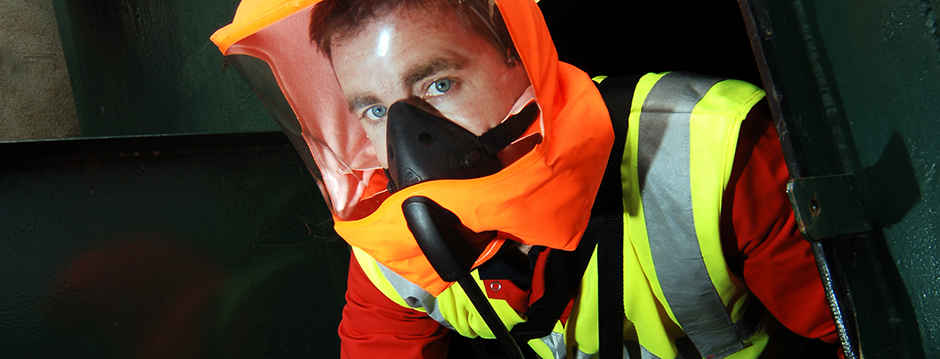
Respiratory Workplace Protection: Fit Testing
Arguably the most important part of the Respiratory Protective Equipment (RPE) process is fit testing. This ensures that tight-fitting respiratory apparatus works well and keeps dangerous substances away from the mouth and nose and, ultimately, out of the body.
Fit testing will need to be present in many fields, from building and construction to manufacturing, chemical handling and medical care.
The HSE states that "a major cause of leaks is poor fit", adding that "tight-fitting facepieces need to fit the wearer’s face to be effective".
If a mask is too loose, particles and fumes can enter the respiratory system, causing both short-term and long-term health issues.
Choosing the correct mask for your wearer involves both personal choice and comfort as well as finding the right mask for the job. For instance, you may need to have a mask which has additional motorised breathing help if you're in an enclosed space where a lot of fumes are produced. You'll also need to choose a mask with a seal that can adapt to face shape and facial features.
BOOK A FIT TEST TRAINING COURSE ONLINE
Qualitative and Quantitative Fit Testing
Here at Speedy, we provide training for both Qualitative and Quantitative Fit Test Training. But what is fit testing?
Qualitative Face Fit Testing is used to determine the seal quality of face masks, and relies on the person's sense of taste to judge how secure the mask is. If the person can taste any spray solution, the seal is not effective.
Quantitative Face Fit Testing is different in that it doesn't rely on the individual being tested. It uses more scientific methods, such as particle counting, to judge how effective a seal is. They will need to work in an environment which simulates a natural working environment to check the seal of the mask. A device will then be used to judge how many particles have entered the mask in that time, compared to how many are outside the mask at that time (i.e. how many particles the mask has stopped).
Do I Choose Qualitative or Quantitative Face Fit Training?
The type of respirator fit testing you require will depend on the type of mask you require and prefer, the budget of your workplace and whether testing will be carried out in-house.
Choosing Qualitative testing can keep costs down, as it is more simple and doesn't rely on extra machinery. However, it does rely on the senses of the individual so particles could be entering the mask without detection. It can be more difficult to determine the quality of the seal.
Quantitative testing is pricier, however, this is mostly an initial investment for equipment. You may need to test externally to simulate the actual working environment.
But what you choose also depends on the type of mask you're using:
- Disposable masks can use either qualitative or quantitative testing
- Half masks, including those attached to air tanks, can use either qualitative or quantitative testing
- Full-face masks can only use quantitative fit training
What You Need To Do
The HSE advises: "If an employee wears more than one type of tight-fitting facepiece, then each type of facepiece should be fit tested."
In terms of who needs to carry out this procedure, it needs to be done by a trained employee who has taken the relevant Health and Safety course in qualitative or quantitative face fit testing, and who is given the designated job by the company.
Testing employees also need to be given the appropriate information and job guidance for every fit, so they can best match the mask to their needs.
"RPE fit testing should be conducted by a competent person - you should take steps to ensure that person who carries out the fit test is appropriately trained, qualified and experienced, and is provided with appropriate information to undertake each particular task," the HSE states.
Facial Hair
Facial hair may reduce the sealed fit of a mask to the face. This includes short stubble as well as beards. Clean-shaven skin will benefit from a closer fit.
If facial hair is a personal or religious choice, there are options for RPE which can be beneficial, such as full face covers which don't rely on a sealed fit to the face and instead will involve neck seals.
- 2024
- 2023
- December 2023 (13)
- November 2023 (10)
- October 2023 (6)
- September 2023 (10)
- August 2023 (20)
- July 2023 (21)
- June 2023 (17)
- May 2023 (17)
- April 2023 (17)
- March 2023 (14)
- February 2023 (15)
- January 2023 (7)
- 2022
- December 2022 (6)
- November 2022 (12)
- October 2022 (24)
- September 2022 (14)
- August 2022 (12)
- July 2022 (15)
- June 2022 (18)
- May 2022 (14)
- April 2022 (9)
- March 2022 (5)
- February 2022 (5)
- January 2022 (2)
- 2021
- December 2021 (7)
- November 2021 (10)
- October 2021 (1)
- September 2021 (1)
- August 2021 (3)
- July 2021 (3)
- June 2021 (4)
- May 2021 (1)
- April 2021 (1)
- March 2021 (2)
- February 2021 (1)
- January 2021 (1)
- 2020
- 2019
- 2017
- 2016
- 2014
- 2013
- 2012
- 2011


